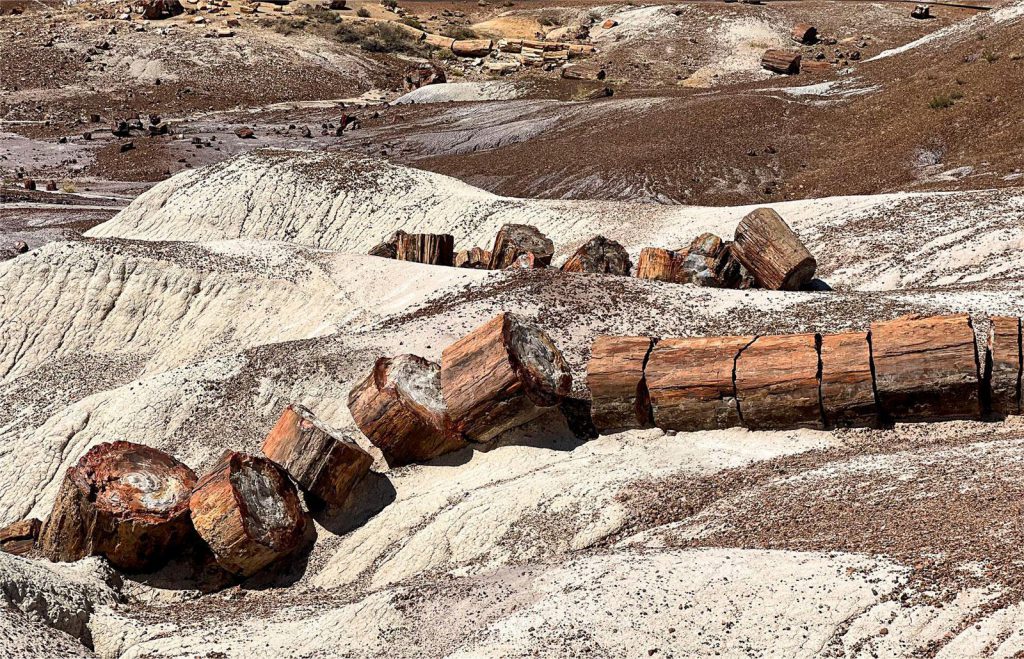Content
In the midst of the breathtaking desert landscape of Arizona, a prehistoric treasure can be found, the Petrified Forest National Park. This vast expanse of 346 square miles (346 square kilometers), once home to ancient rivers and lush forests, is now a colorful canvas of rock formations and petrified logs, a silent testament to geological changes over millions of years. Whether you’re a nature lover, a geology enthusiast, or an adventure seeker, this article will take you on a journey through this unique national park, providing a glimpse of its astounding geology, wildlife, rich history, and offering useful tips for planning your visit.
Introduction
History and Designation as a National Park
The Petrified Forest National Park was designated as such in 1962, but the region’s history dates back over 200 million years when it was inhabited by giant reptiles and prehistoric trees. The remains from that era formed the fossils and petrified logs that characterize the park today.
Location and How to Get There
The park is located in northeastern Arizona, west of the USA, along Interstate 40. The park can be reached from the nearby cities of Holbrook and Navajo.
Geology and Landscape
Geological Formation of the Petrified Forest
The park’s geological formation is a testament to the Triassic era, about 225 million years ago. During that time, enormous tree trunks were buried in mineral-rich sediments, which eventually petrified the logs, creating fossils of trees turned into stone.
The Petrified Trees and How They Formed
The petrified logs visible in the park today are actually fossils of trees that were buried and mineralized millions of years ago. This process of petrification is what has preserved the incredibly fine details and coloration of the logs.
Notable Geological Features
In addition to the petrified logs, the park hosts a range of fascinating geological features, including the strikingly colored strata of the Chinle Formation, the picturesque stone structures in Blue Mesa, and the iconic Tepees, whose color patterns visually testify to the different layers of sediment deposited over time.
Flora and Fauna
Native Plants of the Petrified Forest National Park
The Petrified Forest National Park might seem like a harsh terrain, but it harbors a variety of native plants. Wildflowers, cacti, and desert grasses have adapted to the desert conditions, flourishing and bringing life to this ancient geological landscape.
Wildlife and Common Sightings
The park is home to a diversity of wildlife. Visitors can expect to see animals such as coyotes, desert hares, snakes, lizards, and a plethora of birds, including the common raven, hawks, and raptors.
Conservation and Management of Flora and Fauna
The Petrified Forest National Park plays a crucial role in protecting and conserving these species and their habitats. Ongoing efforts are made to manage the park’s ecosystems and safeguard its biodiversity.
Activities and Attractions
Hiking Trails and Excursion Opportunities
The park offers a variety of trails and excursions for visitors, allowing them to explore and experience the beauty of this national park up close. The Blue Mesa Loop Trail and the Giant Logs Trail are particularly popular.
National Park Museum and Visitor Center
For visitors interested in learning more about the history, geology, and wildlife of the park, the Rainbow Forest Museum is a must-visit. The Visitor Center also provides information and helpful resources for visitors.
Photography and Bird Watching
With its unique landscape and diverse fauna, the park offers plenty of opportunities for photography and bird watching. The diversity of bird species and the park’s natural beauty make it a perfect spot for ornithology and photography enthusiasts.
Driving Through the Park and Panoramic Views
The Petrified Forest National Park can also be explored by car along the 28-mile scenic route. The route offers a series of panoramic viewpoints where visitors can enjoy stunning vistas of the park.
Culture and History
Indigenous History and Archaeological Sites
The park houses several archaeological sites that speak to its rich indigenous history. The Pueblo ruins and the petroglyphs at Newspaper Rock are testaments to the region’s indigenous past.
Colonial Period and Pioneer History
In addition to its indigenous history, the park also carries a legacy from the pioneer era and westward expansion. The remnants of the old Route 66 and Agate House, a cabin built by settlers in the 19th century, are examples of this period.
Artists and Cultural Inspiration of the Petrified Forest National Park
Throughout the years, the park has served as inspiration for countless artists, photographers, and writers, who have captured and shared its unique beauty with the world. The picturesque landscape and serenity of the Petrified Forest National Park continue to captivate and inspire people to this day.
Practical Information
Best Time to Visit the Petrified Forest National Park
The park is open year-round, but the best time to visit is spring and fall when temperatures are more moderate. During these months, conditions are ideal for hiking and exploring the park.
Park Rules and Regulations
It’s important to respect the park’s rules to preserve its natural beauty and biological diversity. This includes not collecting or disturbing the petrified logs and other natural and cultural resources in the park.
Available Services and Accommodation
The park offers various services, including picnic areas, restrooms, and a gift shop. While there is no lodging in the park, there are several options in the nearby cities of Holbrook and Navajo.
Tips for Safety and Park Conservation
Being prepared for desert conditions and bringing water and sunscreen is important. Visitors are also encouraged to practice Leave No Trace principles to minimize their impact on the park.
